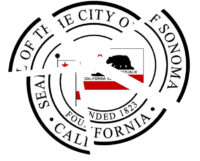The Wednesday meeting of the Sonma Valley Hospital board, complete with cake and beverages, was an occasion for congratulation and appreciation of all those who helped make the most recent bond measure campaign a success. The festivities included a welcome to new board members and salute to those who were stepping down.
Board members Mike Nugent and Mike Smith took their leave with fond words to a packed room. “I’m astounded at what we did together,” Nugent said. Smith thanked his wife, Susan, for all her support, and said he’d be writing about the experience in his book.
New board members, Madolyn Agrimonti and Peter Hohorst were sworn in and new officers were elected. The other board members are Bill Boerum, newly elected chair, Dick Kirk, vice chair, and Arnold Riebli, treasurer. Agrimonti is the new second vice chair and Hohorst is the new secretary. Boerum, recalling the tough times the hospital board has been through, said of Kirk, “Dick, you’ve been a conciliator, an innovator and the best possible chair we could have had.”
Getting down to business, Kirk noted that the strategic planning committee has withdrawn its report for this evening, so the board altered the agenda and recognized Chief Executive Officer Carl Gerlach, to present his report next.
After a year of downbeat financial reports, Gerlach was pleased to say the financial picture has been good for four months in a row. “There’s a net income through October of $615,000, which is $384,000 over budget –– which is pretty good in all respects,” he said. Patient-day volume was above the prior years, but are slightly under budget. “Three months ago, I said the challenge would be to be able to manage the volume fluctuations in a small hospital. Very, very challenging.” Key to that challenge is managing the labor costs without alienating the staff – a task which is “very tough.” But, he said Chief Financial Officer Jim McSweeney has developed a labor management tool being used by nursing and, “They’re tight. They’re really tight.”
On revenues, he remarked on how well the hospital has been able to recover. “I think a year ago, we were embarking on a horrible experience, having the hospital’s program hit the wall, but with the help of our primary care physicians,” he said, “we were able to bring it back.” He said the profile at the hospital is changing and they are able to treat and hold more medical cases. He said the intensive care unit has increased in its volume by 20 percent. Last month, it was up 40 percent from the prior year. “It’s true the surgical volumes haven’t improved as much as we’d like, but the medical volumes have covered the base.” The bottom line, he said is that volumes haven’t quite increased as much as they’d expected, but they’ve managed their labor costs very well. “And it’s kept us in business,” he said. “It’s a good story.”
Part of his management discipline, Gerlach said in an interview earlier in the day, involves “line by line” evaluations of all the areas of the hospital. For example, currently, the obstetrics and gynecology department is going through a review. “What we’re doing,” he said, “is a serious evaluation of OB to determine how to do it with as high a quality as we can.”
Gerlach announced some new developments at the Carolyn J. Stone Women’s Center. Now that the Perkins Street site is up and running and the digital mammography and bone density machines are being kept busy, a recent survey will serve as a guide to what the center needs.
The survey, done by Dr. Patricia Brooks and Phyllis Kirk, consisted of eight focus groups to determine the needs of community women and how the Women’s Center can respond. The surveys identified the following priorities: First, obstetrics and gynecology (OBGYN) services. “We have only one OBGYN,” Gerlach said, “so we have a need.” The survey also cited a need for wellness services, an interest in alternative medicine, mammography and bone density testing – which are in the center at this time – eye, hearing and dental exams, and then, “very clearly,” they recognized a shortage of primary care physicians.
The target now, said Gerlach, is to recruit one female OBGYN and to recruit female primary care physicians. Also, he said, there’s a need for “navigational and informational services,” to help people work their way through the morass of health care systems. He said his recent experience with his mother, in the health care system – even though he himself is a professional – “was just nerve wracking.”
The plan now, he said is to establish a women’s clinic within the Women’s Center. “We’re going to use a structure called a 1206D, a form of clinic that’s been well tested. The clinic structure will enable them to recruit doctors, and they’ll be especially looking for a female OBGYN.
Gerlach’s report moved on to an update on the facilities upgrade, in which he is working on a glitch in the SB306 approval process. “We’ll work through it,” he told the board. “They’ll not close Sonoma Valley Hospital.”
Sonoma Valley Hospital announces new board members, officers and clinic
More from What's HappeningMore posts in What's Happening »
- Board of Supervisors boosts Sonoma County’s Living Wage to $23.15 per hour starting July 1
- Sonoma County Board of Supervisors pledges to safeguard civil rights of immigrants
- Small Is Beautiful Film About SDC to be Shown Sunday, January 19 at 2 PM
- Transition to District-Based City Council elections on the City’s Agenda for Jan. 15th




